Stefania — The Queen of Icelandic Sheep
Part One — The First Importation of Icelandic Sheep to North America
This article is based on a taped interview with Stefania during a visit to Yeoman Farm in 1995. Stefania died of complications from cancer in 2007. This is her story of bringing the Icelandic Sheep breed to North America.
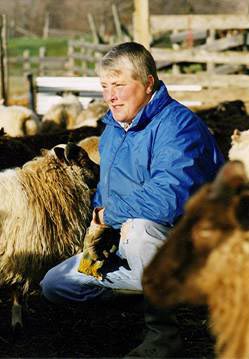
I rang the doorbell of the old two story white farm house in the rural village of Parham Ontario not knowing what to expect. The 5 foot “something” woman that opened the door was surprising. The first thing I noticed about Stefania was her gold front tooth that flashed at me as she smiled. The second thing I noticed were her eyes that were sparkling, lively and full of self confidence. Her posture was very erect like a ballet dancer carries herself, and she cocked and wagged her head when she talked in such a way that exuded self confidence with a twist of mischief. That first impression suggested that she would look at home in a swash-buckling pirate’s costume. She was intriguing, well educated and engaging to say the least. From there on the visit was a whirlwind of seeing the largest flock of Icelandic sheep in North America, and I was overwhelmed. I took as many photos as I could so that I could study them later. I spent a lot of time just wandering around looking and observing the animals with Stefania telling the stories about each ewe or ram.
I was there to get some additions to the animals that I had bought from Stefania the previous year. I was hungry for information on this breed, and Stefania was the only source. I asked her to tell me the story of how she imported the sheep. She was cooking dinner for us and started talking as I clicked on the tape recorder. From the two tapes she filled with stories and laughter, the events of her life unfolded.
Born and raised in Reykjavik Iceland, Stefania Thordis Sveinbjarnardottir had no idea what a profound effect her 1968 visit to Canada (to be with her pregnant sister) would have on her future. She also never dreamed that her mission in life would be to introduce the Icelandic sheep breed to North America. During that first visit to Canada in1968, she fell in love with the Canadian landscape and friendly people. After a year in Cypress, she went back to Iceland but kept thinking about Canada. In 1971, she returned for a three week bus trip, accompanied by her first daughter, which took her from New York through Quebec. This trip was the deciding factor, and in1973 she immigrated to Kingston, Quebec and got a job in accounting.
Shortly after she arrived, she met Ray Dignum, an electrical engineer and professor at The Royal Military College of Canada, and they were married sometime after. When Ray’s parents died and left him a small inheritance, they decided to try and find a country home and live the “Harrowsmith” dream of a back-to-the-land lifestyle. ( Harrowsmith was a magazine similar to The Mother Earth News.) The thinking at the time was: “If there was war you could live in your basement and eat your cows”, Stef quipped.
An extensive search turned up a rundown farm with an old house in sad shape and a big old timber framed barn. The realtor coyly whisked them rapidly through the house (that needed a lot of repair), and out onto the mature sugar bush. The sugar maples were at peak fall color with brilliant scarlet leaves against dark tree trunks and looked like a magnificent cathedral. Stef and Ray were sold on the spectacular beauty of the place and didn’t notice the numerous rock outcroppings and massive boulders rising out of the land in profusion which relegated much of this land to poor quality grazing at best. They were mainly concerned about the one hour commute to Kingston each day. After they found a co-worker that had been making the commute daily for 13 years, they decided that if he could do it, then they could too.
Stef and Ray moved to the farm on the outskirts of the village of Parham in the spring of 1979. They named it Yeoman Farm after the name of the playing field at Ray’s old school in Tonbridge, Kent, England. Their friends in Kingston gave them only two to three years before they would become disenchanted and return to the city. Both Ray and Stefania were indeed city kids; Ray having been raised in the outskirts of London and Stefania in the Iceland capital city of Reykjavik. It was a crazy dream, but they both continued working in Kingston for three years until the demands of the growing farm got too great. It was logical for Stefania to be the first one to quit her job as she was expecting the birth of her second daughter, Louise, and because Ray had better pension opportunities.
At first they had rabbits, then 15 sheep and 3 cows, some horses and pigs. A jersey cow hand milked by Stefania provided all of their butter and milk. Stef even tried her hand at cheese making. The basement soon filled up with wheels of cheese that were turned everyday for 6 months. The first taste of their home made cheese stopped all further cheese making as it had a sour rotten flavor. Other homestead projects were also disappointing. The jersey had twin heifers but when bred back via AI, the cow developed toxoplasmosis from infected semen, aborted and was sent to auction.
From the start, Stefania didn’t realize that the sheep in the rest of the world did not look like her beloved Icelandic sheep for which she was getting homesick. You see, she explained, as a child she and other Icelandic children were sent out to the countryside for the whole summer to live on the sheep and dairy farms of friends and relatives. This was partly to help out with the farm work and partly to strengthen family ties. These were wonderful carefree days filled with games, cooking and Icelandic sheep. The kids helped out by taking out the stove ashes, raking the hay, bringing the cows home at night to be milked and carrying coffee to the field workers.
The kids all played “farm” in the way that Icelandic children had played it for centuries. Sheep bones and horns were their livestock. The horns were the sheep, the long leg bones were the horses and the small pastern bone was the dog. The jawbones turned upside down were the cows with the molars being the udder. The children built small turf houses just like the traditional houses of the original settlers. To imitate the big fall round up the children would fling the horns (sheep) far and wide and then use the horses (leg bones) and dogs (pastern bones) to gather the sheep. These traditional toys were used from the beginning of time until, sadly, plastic animals became available.
The kids were imitating the annual Fall sheep round up, called a Rettir , which happens each Fall in Iceland when the sheep are gathered up from the thousands of acres of rough wild mountainous open range and returned to their farms for the winter. Each district has its own Rettir in the fall, and these events are community celebrations complete with drinking, singing and sorting the sheep.
Some of Stefania’s fondest memories were of these childhood farm visits. She related a story about one time in particular when she was a young girl, sitting on the unfinished floor of a new farm house that was being built. She was playing with a box of shells and bowls while the lady of the house sang and spun wool. This was one of those rare moments in a person’s life that is so peaceful and perfect and as close to nirvana as most of us get here on earth, according to Stefania. She used this visual image of peace when she faced tough times in her life.
Iceland at that time was safe for children to travel unaccompanied. Stefania related one story when she was 8 years old and traveled by herself from the summer farm in the country, taking the plane and bus to reach her home in Reykjavik. She surprised her family who hadn’t expected her. This confidence built up at such early age helped “Disa”, as she was nicknamed by her family, to demonstrate the confidence and self assurance she would need many times later in her life.
So here she was, years later in the Canadian countryside, ready for Icelandic sheep. In all of her searching, she could find only two wild, crazy, fence-busting. expensive Scottish blackface sheep, an old rambouillet ewe, a few Dorsets, Suffolks and Hampshires. But these were not the sheep of Stefania’s childhood. These more modern breeds had a loud guttural "Blah Blah", and sounded off frequently. She remembered her beloved Icelandics as having the soft occasional "Ma Ma" bleatings. These modern breeds were “ugly” in Stefania’s way of thinking, all white and polled, and not the multi colored horned beauties of her childhood.
Since there were no Icelandics to be found in North America, she and Ray settled for some Columbia sheep from 3 different breeders. One breeder in the USA was auctioning off his whole flock. Unbeknownst to Ray and Stefania, this flock was infected with OPP (Ovine Progressive Pneumonia), a virus that wrecks havoc with the health of a flock. The Columbias didn’t thrive. The lambs were weak, the ewes became skinny and started dying. Neither Ray nor Stef suspected the cause was OPP. Stefania knew that Icelandic sheep were much hardier and healthier than the Columbias that they were trying to raise and wrote to Iceland to ask about the breed. The response that came back described an animal that finished at 90 to 100 pounds and gave 4 to 5 pounds of wool. This was disappointing in comparison to the 15 pounds of wool that the Columbias gave along with the 120 pound lambs they produced. Then Stef realized that the Columbias took a year to reach that 120 pound size while the Icelandic lambs reached the 90 to 100 pound size in 4 to 5 months on pasture and mothers milk which made them efficient producers of meat and fleece.
Meanwhile their mixed flock of Columbias, et al, continued to do poorly. Finally in desperation Ray said, “If we are losing money anyway, we might as well lose it on something that we want to have”. He gave Stef permission to try to import some Icelandic sheep from Iceland. In 1984, Stefania flew to Iceland to help celebrate her mothers 80th birthday and told her family of her dream to own and raise some Icelandic sheep on her farm in Canada. Her family advised her that it was against the law to export the sheep: “It is illegal and no one has ever done it”, they said. But Stef thought, why not try for it? What did she have to lose?
She went to the Minister of Agriculture, the Agricultural Society and the Chief Veterinarian of Iceland. They all agreed to issue her a permit to export the sheep if she met all of the conditions of the Chief Veterinarian of Iceland. They also said that several Americans had tried before to export the sheep but that there was no follow through. The vet at that time was Dr Paulsson , a difficult man to deal with and one of the world's leading authorities on Scrapie and OPP. He gave his OK for the export thinking perhaps that this project would go no further. Stef left Iceland with a permit to export 12 sheep. Her plan was to go to Iceland the next fall and pick out the sheep and somehow get them to Canada. Back in Canada she started working on what she needed to import them. Dr Macklehern was helpful and explained that the sheep would have to fly directly to The Mirabel Quebec Quarantine station.
With this problem overcome, Stef headed for Iceland in September with her toddler daughter Louise in tow. In New York their flight was delayed because of engine trouble. This was all that was needed to send Stefania, who was terrified of flying, back to Canada on the next flight, “...like a dog with its tail between its legs”, she said. As it turned out it was just as well; unbeknownst to Stef, there was a general strike going on in Iceland, and it would have been impossible to get the needed lab and paperwork completed.
The next spring she and young Louise tried again, and made it to Reykjavik Iceland where she presented her permit to the woman at the Ministry of Agriculture. This woman told her that permits were only good for one year and that hers was now outdated. Stefania looked at the permit, noted that there was no expiration date on it, and declared the permit was still valid. She then moved quickly and got a list of sheep breeders and farms in the Vestur-Skaftafellssýsla area from Dr Dyrmundsson, her mentor and an Icelandic sheep specialist. The above named area is a province on the East side of Iceland that is isolated from the rest of the country by glaciers, rivers and the sea. Canada would only accept sheep from this area of Iceland, because the animals in this area had never been exposed to the diseases that were brought to Iceland with an earlier importation of rams from Finland that was meant to improve the meat characteristics of the breed, but instead introduced new diseases to Iceland.
Most Icelandic sheep graze communally on vast portions of open range in the interior of the country during the summer. Disease could readily spread in this communal open range setting. Only those sheep that were isolated from mingling with this national flock were saved from infection. The sheep isolated in the Vestur-Skaftafellssýsla district in SE Iceland were free of diseases so it was from these flocks that Stefania could select her 12 sheep.
Now Stefania faced the problem of finding sheep to buy. It was May when the sheep are customarily let out on the vast open range and are not at their home farms. But Stef persisted and she began to accumulate sheep. The minister of Agriculture had a good ram born at his Hunkubakkar farm, a polled white fellow #830, who was built like a pig. A young couple that had taken Stefania seriously the year before had held back some yearlings, and Stef selected a white horned ram, and 5 ewes from Kirkjubaejarklaustur farm. Stefania wanted more colored ewes. She called around to locate 2 greys and one moorit (brown) ewe. One of the grey ewes was scrawny and wild. Then a polled black ewe was found and another moorit ewe. They were each purchased for meat price plus 10% which equated about $300.
Stef had bought rams from brothers that had a friendly rivalry. One raised horned sheep and the other polled Icelandics. Each thought that their genetics were better. When the rams were weighed, the horned ram outweighed the polled one by 10 kilos. The owner of the horned ram quipped, “Go tell my brother that the horns weigh 10 kilos!”
The next job was to gather the sheep and put them in quarantine on one farm for two weeks while the blood work was done. Everyone was helpful as Stef drove through the middle of the night making the arrangements accompanied by tiny Louise, holding her blanket closely. The blood samples were taken by a nearby vet. His wife was furious that Stef intended to take the sheep out of the country which was against the law, and she tried to discourage her husband from taking the samples. However, the blood samples were drawn and taken to Reykjavik. It was the weekend and so the samples were taken to the house of Dr Siversson whose wife was used to having blood samples in her refrigerator. From there the blood was flown to Norway to be tested for B. Ovis, Lepto, Johnes and Chlamydia. Testing took the full two weeks.
When the tests came back negative for disease, the next step was to pick up the final papers from the Chief Veterinarian's office. He was angry (presumably because he had not expected her to follow through with this importation and now was being put in an awkward position) and told her that there was one paper missing that had not arrived from Canada, that she couldn’t leave without it, and he pushed her out of the office with a terse goodbye and closed the door behind her. She was terrified that all of her hard work would go down the drain.
The next morning was Saturday and she had scheduled to meet the pilots to pay them one half of their fee, the second half being guaranteed by her brother-in law in Iceland. At 9:00 she met with the pilots and told them about the unexpected problem. “So we are not going then?” one said. The other urged her to try and call Dr Macklehern in Canada to see if the problem could be fixed. Because it was Saturday all offices in Canada were closed, but she vaguely remembered Dr Macklehern talking about his home in Anprior. She found his name with the help of directory assistance and called. After many rings, he answered. He was just going out the door for the weekend and said, “No,” she didn’t need any further papers and, “Yes”, she could proceed with the importation. He further volunteered to call Goose Bay, Canada and get permission for them to land there to refuel before going onto Mirabel, Quebec. While Stef made the calls, toddler Louise sat under the desk and sucked her thumb.
The two young pilots that Stefania hired agreed to take the seats out of their Cessna to accommodate the 12 sheep crates and to fly the sheep from Iceland to Canada for $14,000. The instructions from the Chief Veterinarian in Iceland were that the pilots would have to take a gun along as a safety precaution and shoot any sheep that caused a problem! Furthermore, the sheep were to be watered at each refueling stop.
The sheep had to be brought to the Keflavik airport in Iceland from their home district for their flight to Canada. Iceland’s Chief Veterinarian assumed that Stef would haul them by truck from the farm, many miles away, to the Keflavik airport, and a permit was needed for this. The vet thought that he had Stef in a "Catch 22", since Iceland’s disease prevention laws did not allow live sheep from a district to be transported through any other district and several districts had to be passed through to get to the airport. Had Stefania had asked for a permit, it would have been denied and the export would not go through. But Stefania knew nothing of this law so never applied for a permit. Instead, she had planned to have the Cessna fly to the sheep’s home district and land on a little known emergency airstrip to load. In this way, the sheep would be able to get to Keflavik without needing a permit, but not breaking any rules either!
At this point nothing could stop the exportation except the weather. Monday came and the airport was socked in. Time was of the essence as the space at the quarantine station in Mirabel Canada, would only be held open for the sheep for three days, Monday through Wednesday. If she missed this window, she would have to wait for another opening to bring the sheep in at another time.
Meanwhile the Icelandic press got wind of the project and asked for an interview and photos. Stefania granted the interview only if the news release was timed for publication only after the sheep's successful departure on the Canada- bound plane. The press agreed.
Monday came, and there could be no departure as the Keflavik airport was socked in by bad weather. Bright and early Tuesday morning at 6 AM, the pilots were at the airport and took advantage of a break in the weather to fly out to the sheep’s home district to pick them up. The plane then flew back to refuel at Keflavik as fast as possible and soon after departed for Greenland. The timing was a miracle as this was the only window for flying for the next week. The next stop after Greenland was Goose Bay Canada to refuel and then on to Mirabel, Quebec.
While the pilots and sheep were making their way to Canada, Stefania flew home via a commercial airline, drove to Mirabel with $7000 in cash in her pocket to meet the pilots at 11PM. They needed to be paid cash as they had spent all they had in Greenland. When she shelled out the cash from her big wad, they exclaimed, “Are you crazy carrying all that cash?” "Crazy" might not begin to describe what Stef had just accomplished!
At Mirabel, the sheep were unloaded into an open trailer with a man hanging on the side for the ride to the Quarantine station. His purpose was to beat the sheep on the head when the frightened animals tried to leap out! When the sheep were safely penned, Dr Durocher showed Stefania around the facility. In the quarantine pens were animals of all kinds. But one was very unusual. It was a pot bellied pig from Vietnam. This was the first brought into North America and started the pot bellied pig craze. The sheep stayed at Mirabel for 30 days during which they were retested and then released. The costs included: $2000 for the quarantine, $15,000 for the plane and blood tests, and $4944 for the sheep. Including Stefania’s travel expenses, the total cost was $25,000 for 12 sheep or $2083 each.
Back in Iceland, as soon as the sheep left the airport for Canada, the press released a news bulletin about the export followed by a newspaper article the next day. Angry protest letters to the editor followed noting that the export was illegal and that Iceland was losing its special animals. Some letters accused Stefania of being a crazy foreigner; other letters were negative against Icelanders that didn’t want to live in Iceland but were taking the animals out.
“But it was too late to close the barn door when the horse was already gone”, quipped Stefania. Later, when things quieted down, the Iceland parliament passed a law allowing her export after the fact. Stefania had pulled off a caper that would make a pirate proud.
When Stefania got the sheep home, she put them in the most secure front pasture as Icelandic sheep are known to have a homing instinct. Because of this homing instinct, adult ewes in Iceland are not sold to another farm, only lambs. But the sheep in their new home in Canada settled in nicely. The sheep import adventure was to be only the first trial that Stefania would be called upon to deal with in her life as a shepherdess.
Included in that first import were the following Icelandic sheep which were to become the founding animals for the Icelandic Sheep breed in North America. All photos of the sheep are from Yeoman Farm and used with permission:
| Name | Photo | Registered Name | Description/Notes |
|---|---|---|---|
| EWES | |||
| #042 Lengja |  |
ICELAND EWE SOL 42 365255H | White horned ewe. She came from Kirkjubaejarklaustur farm. She had a beautiful soft fleece and had 14 lambs in 6 years. She had good conformation and her temperament was calm but not particularly friendly. She has 7 registered lambs. One of her most productive daughters was STS29A. |
| #043 Nebba | 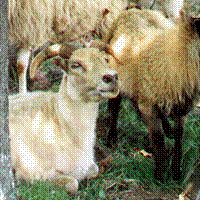 |
ICELAND EWE KL 43 365253-H | White horned ewe. Also came from Kirkjubaejarklaustur farm. Lengja and Nebba had a common grandsire, Solomon, an AI ram. Nebba had the same soft fleece as Lengja but had only 8 lambs in 5 years. Nebba had good conformation and a wonderful friendly temperament. She carried the badgerface pattern and introduced that pattern into North America. Nebba means nose and Nebba had a dark nose. She had 6 registered progeny. |
| #068 Grana | 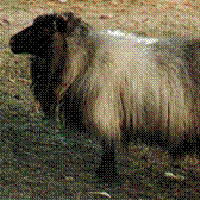 |
ICELAND EWE 00068 365245-P | Grey polled ewe. She came from Bakkakoti farm. She was small with medium fine wool. She only had 6 lambs in 4 years. Her temperament was rather horrible. She was wild, unfriendly and fought all the way. You might ask why Stefania selected her: she was selected because she was colored and so few colored sheep were to be found at that time. She had 3 registered progeny. |
| #108 Thora | 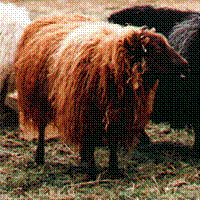 |
ICELAND EWE 108 365248-S | Moorit polled ewe. She came from Pykkvibaer farm. She had 9 lambs in 6 years and had the first register able lambs born in North America. Pora had very fine wool that really felted by Spring. She was quiet, unassuming and loveable. Her lambs had a friendly disposition. She was fine boned, medium size and average conformation. She was a dark moorit and stayed dark. She had 7 registered progeny. |
| #222 Mora | 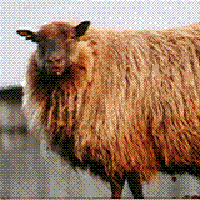 |
ICELAND EWE 222 365246-P | Moorit polled ewe. She came from Bakkakoti farm. She was a good big ewe with a lovely fleece. She had good conformation and a quiet temperament. Mora had 11 lambs in 6 years and had a strong influence on the breed since her sons were the first colored rams born and were used extensively. She had 6 registered progeny. |
| #350 Leira |  |
ICELAND EWE 0350 365247-P | Grey polled ewe. She came from Bakkakoti farm. She was big with a lovely fleece and good conformation. Leira was friendly and had big lambs. She had 9 lambs in 6 years. One of her sons, STS82W, grew very fast, almost a pound a day from birth to weaning. She had 5 registered progeny. |
| #400 Svort |  |
ICELAND EWE 0400 365251-H | Black horned ewe. (Svort means black in Icelandic) She was the leader of the imported group and a wonderful intelligent ewe. She probably had some Leadersheep genetics. She came from Kirkjubaejarklaustur farm. She was big and had very good conformation and somewhat coarse fleece. She had 12 lambs in 6 years. She had 8 registered progeny. |
| #403 Dokkvor | 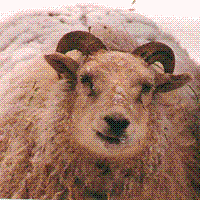 |
ICELAND EWE LV 403 365252-H | White horned ewe. She came from Kirkjubaejarklaustur farm. She was big and had very good conformation and medium wool. She was shy but not wild. She lived only 3 years and had 4 lambs. She died of pneumonia and a bad udder. She had 4 registered progeny. |
| #423 Fluta | 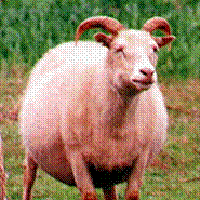 |
ICELAND EWE 423 365254 | White horned. She came from Kirkjubaejarklaustur farm. She was big with good conformation. Her wool had extremely coarse tog. She had 4 sets of twins and was open one year. Her temperament was not particularly nice. She stamped her feet a lot and hissed at people. He name Flauta means whistle which her hiss sometimes sounded like. She was not aggressive; just stood her ground. She died from a bad udder. She had 5 registered progeny. |
| #453 Segla | 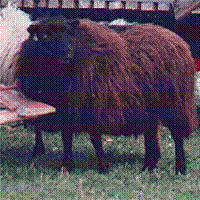 |
ICELAND EWE 453 365249 | Black polled ewe. She came from Seglbudir farm. She was small and loveable. She had a lamb in Iceland but lost it. Even though she was small, her conformation was excellent. She is STS7A Saddleback’s grandma and had the same build as Saddleback. She had 11 lambs in 5 years plus the one in Iceland. Her fleece was soft but not very long. She had 9 registered progeny. One of her most famous daughters is STS37Z Golsa. |
| RAMS | |||
| Larus #723 | 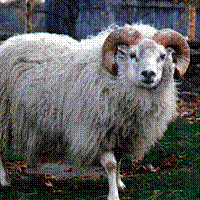 |
ICELAND RAM LV 723 365256-H | White horned ram. He was named for the Farmer that bred him. He came from Kirkjubaejarklaustur farm. He was a big ram with good conformation and a medium fine fleece. He was friendly, calm and a good breeder. His horns had been cut in Iceland even though it would not have been necessary. He had 17 registered progeny. |
| Tritill #830 | 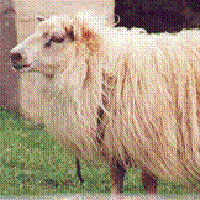 |
ICELAND RAM 830 365250-P | White polled ram. His name means “Shorty” to reflect his short broad conformation. He came from Hunkubakkar farm. He was wild, had a bad temperament and was impossible to catch. But he had a wonderful conformation; blocky and short legged like a pig, and a lovely fleece. He had 10 registered progeny. |
Part 2 will tell about her fight to save her wonderful Icelandic sheep and their offspring from OPP, a virus, which the healthy imported sheep contracted in Canada from Stefania’s Canadian-born sheep.
Part Two — Stefania’s Impact on the Breed and Much More
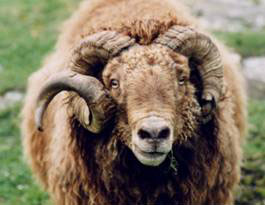
Stefania finally had her beloved Icelandic sheep. Life was good for awhile. Then in 1980, the Minister of Agriculture in the province of Quebec Canada offered free testing for the virus Ovine Progressive Pneumonia (OPP) to all sheep flocks as a new trial program. Stefania decided to join the program. Stefania was well aware of OPP as this virus had devastated her grandfather’s flock in Iceland years before. The first tests came back with 33% of her flock testing positive. Stefania was so devastated by the test results that she had to go to bed for three days. OPP is spread through every body fluid including milk, saliva and birth fluids. Stef was told that the only way to deal with OPP was to orphan the lambs at birth and bottle raise them on a separate farm with milk replacer. This meant that she had to attend every birth and never let any lamb nurse its mother. In 1989, 1990 and 1991, she orphaned the lambs of her original imported Icelandic sheep. After three years of testing and destroying the ewes and rams that tested positive, she had three of the original 12 sheep still alive and testing negative. Stef then needed to bring the lambs that she had kept isolated back to her home farm. She made the grim decision to destroy the remaining original imported sheep even though they had always tested negative. Stef just couldn’t take a chance of having them infect the lambs and have to go through the whole process again. Ray shot them behind the barn. Stef was distraught. She said that if she had to do it over again she would not have destroyed the remaining three. Stef continued to blood test all of the sheep every year even though her flock soon tested negative.
Although Stefania told everyone that she would never attempt an importation again, she kept in touch with Dr Olafur Dyrmundsson. In 1990, four years after her original importation, he contacted her and told her that if she wanted to make a second importation, this would be the time because some British shepherds had applied for an export permit and it looked like they were going to get it. But it was all going to be done quietly.
Having just 12 sheep had severely limited the gene pool of the Yeoman Farm flock. Another importation would greatly expand the bloodlines. There were two groups of British shepherds, including one woman that chose 40 sheep. Stefania decided to make another importation. She got promises from several breeders in Canada, to buy some of the new importation. She went to Iceland and traveled with the British party and selected more than 100 sheep from a district further east of the original area where she had gotten the first sheep. Because it was the fall of the year and the sheep had been gathered from the hills and were at their home farms, there was no problem finding animals.
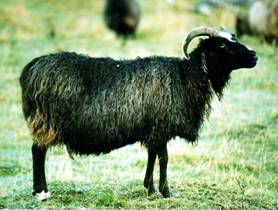
There were 2000 animals on the six farms to select from. This time Stefania knew just what she wanted and selected colored and patterned sheep: moorits, mouflon, spotted and leadersheep. Only one farm had a leadersheep, a ewe with twin ewe lambs. Stef selected the leadersheep and her twins. She also chose 14 ram lambs. The biggest ram weighed 110 pounds at 4 months of age. This time the officials were more relaxed and the importation went smoothly. Stef was even allowed to truck the animals to the airport through other districts.
The bomb dropped, however, when the blood tests came back from Scotland. 30 lambs had a titer for Chlamydia, a bacteria that causes abortion “storms”. The Chief Veterinarian for Iceland was stunned and said emphatically “There is no Chlamydia in Iceland. You don’t miss Chlamydia”. But the positive titers kept these lambs from being exported. One of the reactors was one of the leadersheep ewe lambs. Stef ended up with just 12 rams. The “clean” group of 74 sheep flew on to Canada and was then retested during the 30 days in quarantine at Mirabel. 2 more tested positive at Mirabel for the Chlamydia, and Stefania was upset.
Stef happened to mention the Chlamydia situation to a friend, Christen English who leafed through her Merck manual and found the section on Chlamydia. The test would show positive if the sheep had eaten bird droppings from a carrier bird. Bird Chlamydia is harmless to sheep but will cause a false positive. This was the answer that explained the positive sheep tests as wild sea birds were prolific in the area where the sheep lived and grazed. A call to the quarantine station and to Iceland solved the mystery and allowed all 74 of the sheep to leave quarantine in Canada. Stef had bought one of the rams sight unseen. When Stef saw him at the Mirabel Quarantine station for the first time it was quite apparent that he had bad parrot mouth, a gross conformation defect. He was butchered. Stef said it was the most expensive lamb they had ever eaten.

The costs were only $962 per head this time or $71,188.00 which took most of the Dignum’s savings. Many of the sheep had been spoken for before the actual importation, but when the time came to pay, most potential buyers backed out. The exception was Nancy Pease who ended up with two rams and five ewes. This was the start of Nancy Pease’s flock. The sheep from Stefania’s new importation went directly to a rented farm nearby in Parham and were kept there till the OPP situation on the home farm had been cleared up. Eventually all of the new imports and the lambs that had been orphaned because of the OPP were united on the Yeoman Farm.
The original imports could not be sold to customers in the USA. It took five years before the US would allow the importation of the offspring of the imported ewes to qualify for import. Barbara Webb was the first to import the sheep into the states after many years of paperwork and hounding Dr Roger Perkins at the Animal Plant Health Inspection Service (APHIS). Many other importations followed as shepherds in the US discovered the breed.
Little did Stefania dream that her struggle to get a flock of her beloved sheep from Iceland would be the start of the breed in North America and that she would become the “Queen of Icelandics”. Stefania never promoted the breed too much, although she did write occasional articles in The Shepherd and Black Sheep magazines. If anything, she understated their attributes as she didn’t want any one to be disappointed with the sheep. In the beginning she was the only source of information on the breed. Eventually two breeders in the USA, Barbara Webb and I (Susan Mongold Briggs) were able to start the importation of semen directly from Iceland to add genetic diversity to the North American flock. Other semen imports followed, and now there is a yearly importation of semen for US breeders from the Artificial Insemination (AI) station SOUTHRAM in Iceland There are also occasional classes in Vaginal AI techniques by Dr. Thorstein Olafsson who pioneered the special process. (www.bssl.is)
Stefania helped organize the first Icelandic sheep organization: Icelandic Sheep Breeders of North America (ISBONA) at www.isbona.com and was its first president. The organization was mainly promotional and designed to help breeders with the information they would need to be successful with the sheep. The Canadian Livestock Records Corp (CLRC) agreed to register the sheep and is not associated with ISBONA. This helped keep the registration process from becoming political. The CLRC handles all of the purebred breed registrations in Canada and does a very professional job. (www.clrc.ca)
Stefania was involved in many aspects of the sheep. She helped Beth Abbott do a study on the Icelandic Fleece for Beth’s Master Spinner thesis. Beth eventually published her thesis in a book called The Icelandic Fleece, which is presently out of print. . Stefania already knew how to spin, weave and knit Icelandic wool and had been making garments for years. But to hone her skills, Stefania decided to participate in the 3 year master spinner course given through the Canadian college system and after completing the course received the degree of Master Spinner.
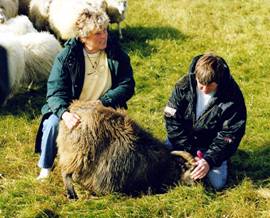
In 1998, Stefania arranged a breeders tour of Iceland which included a visit to the AI station, meat processing location, sheep farms, goat farm, wool processing plant, and a Rettir or Fall sheep round up. Our group made headlines in the Reykjavik paper and elevated the status of sheep breeders in Iceland. Sauvé city dwellers had a hard time believing that sheep breeders from the US would come all the way to Iceland to see lowly sheep! Our group got to see the nitrogen tank that held our first frozen semen import, ready to be shipped. This semen would help widen the genetics of the breed in North America, and we were excited!
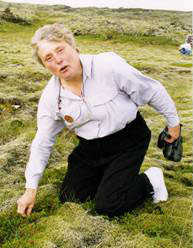
Stef made sure that we all experienced not only the spectacular sights but also Icelandic food like Icelandic breakfasts and lamb fixed in traditional ways. There was delicious skyr, a kind of thick yogurt, to eat and the more adventurous in the group tried pickled shark and sheep eyes. At one point Stefania stopped the tour bus and had us all get out and walk carefully on the very spongy mosses. We picked and tried the berries that were growing there. The spongy moss was 6 to 12 inches deep and we were told that you were not suppose to damage it, as it was the only plant that was able to grow on some of the fragile volcanic land. The moss not only was slowly making topsoil but prevented erosion.
Stefania imported a male Icelandic sheepdog dog from Iceland and started breeding this rare breed after finding a female in Canada. The Icelandic sheepdog is a Spitz type, small to medium-sized dog related to Norwegian Elkhounds. They come in many colors and patterns like all of the Icelandic animals. The smart and personable dogs with natural shepherding abilities have been used for centuries to round up the sheep, catch lambs, kill vermin, keep predators away from the sheep and keep the sheep off of the hayfields. Many of Stef’s sheep customers got a pup as a bonus with their purchase of sheep. Some sheep breeders started raising the sheepdogs themselves and importing new bloodlines from Iceland. A registry was formed for North America.
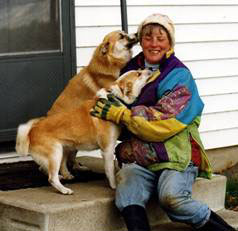
In addition Stefania had a hand in saving the rare Icelandic Goat that produces meat, milk and high quality cashmere fiber. On a visit to Yeoman Farm, Halla Eyglo Sveinsdottir, was made aware of the plight of the colorful Icelandic goat. Stef suggested that Halla write her thesis on the goat. This lead eventually to Iceland’s legislature subsidizing the winter feed for this rare breed making it attractive for breeders in Iceland to save the goat from extinction. Winter feed is the biggest expense for livestock in Iceland.
Because of Stefania’s experience with OPP, Yeoman Farm became one of the first to adopt biosecurity measures. No one got into the sheep area without wearing new or disinfected boots and clean clothes. She had her vet trained to carry disinfecting fluid to treat his boots before each visit. There was a collection of rubber boots in many sizes available for guests to use. You could use your own boots only after scrubbing them in the bathroom and then dipping in disinfectant under Stefania’s strict supervision. Because of Stef’s vigilance, Icelandic sheep got a clean start in North America.
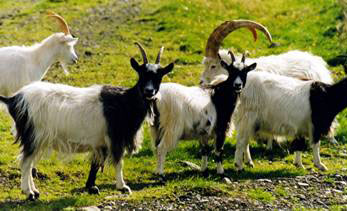
Stefania was always interested in leadersheep. Leadersheep are Icelandic sheep that have exceptional abilities. Weather prediction, watchfulness, a homing instinct and a feel for danger were some of those traits that made them revered in Iceland. There are stories of their abilities that saved many shepherds and their flocks by leading them to safety in white-out blizzards. Stefania imported a leadersheep ewe “Blessa” from Iceland with her ewe lamb. She wanted to breed leadersheep. After the importation of semen made it possible to get Leadersheep genetics, my farm, Tongue River Farm in Montana, had good results with AI and had a ram lamb that was son of Leadersheep, “Ari”. Stefania decided to buy the ram to breed to her beloved Blessa. Importation of semen to Canada was not allowed at that time. So in 1999 Stef bought and imported an “Ari” son from Tongue River Farm. This was a full circle as we had started our Icelandic sheep flock with stock purchased from Stefania.
In 2006, Stefania was diagnosed with cancer and was undergoing treatments. She was responding well and had a good outlook. She had just imported her first semen from Iceland and inseminated some of her ewes using the vaginal method developed by Dr. Thorstein Olafsson after taking his class. She was looking forward to her first AI lambs in the spring of 2007. But suddenly in early February she became very ill, was rushed to the hospital and died 24 hours later on February 4th 2007.
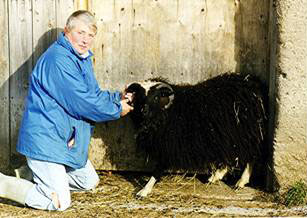
The word of her death spread like wildfire from breeder to breeder in a flurry of tearful calls. We mourned her untimely and sudden death. We had so much that we still wanted to know about the sheep, that she had put off writing until she had the time “in her old age”. This information and all of the stories that she kept in her head will never be told. After her death, the flock was dispersed with some being kept by friends for her daughter, Louise. Certainly we owe a huge debt of gratitude to that brave little feisty “pirate queen” that “stole” the breed from Iceland and made it possible for us to enjoy this wonderful and unusual old world sheep breed in North America.
Stefania was cremated and her ashes flown back to Iceland to be sprinkled on her wild beloved mountains where the Iceland sheep roam free each summer. A fitting end for the Queen of Icelandic Sheep.
These are the sheep imported in the second import. The columns are as follows...
- Registered name
- Registration number
- Number of progeny
- Breeder of the sheep in Iceland
- Sire
- Dam
- Age when the sheep died or was culled
- Owner
- Common name
- Notes
| Registered Name | Registration # | Progeny | Breeder | Sire | Dam | Age | Owner | Common Name | Notes |
|---|---|---|---|---|---|---|---|---|---|
| Iceland Ewe Black 125 | 407942 | 12 | Gisli Jonsson | Hnakki 326-10-Z4452 | Sverta 326-05-Z4453 | Pease | |||
| Iceland Ram Moorit 126Z | 407992 | 19 | Orn Bergsson | Fifill 1026-01-Z4529 | Kibba 1026-11-Z4558 | Pease | |||
| Iceland Ewe White 127Z | 407966 | 4 | Ragnheidur Magnusdottir | Somi RM-100-Z4489 | Onn RM -01-Z4490 | Yarrow | |||
| Iceland Ewe Black 128Z | 407981 | 0 | Vidihlid | Tinni 89-462-Z4510 | Finka 83-189-Z4510 | Eggertson | |||
| Iceland Ewe Black 129Z | 407970 | 14 | Ragnheidur Magnusdottir | Ljofur 87-541-Z4496 | Hrid RM-05-Z4497 | Cooper | |||
| Iceland Ewe Grey 130Z | 407947 | 1 | Litla Hof | Hnappur LH-31-Z4460 | LH 08-24461 | Starviala | |||
| Iceland Ewe Moorit 131Z | 408000 | 1 | Orn Bergsson | Fifill 1026-01-Z4529 | Eva 1026-17-Z4567 | Starviala | |||
| Iceland Ram Grey 132Z | 407946 | 1 | Gisli Jonsson | Bolli 88-095-Z4448 | Blama 326-01-Z4459 | Eggertson | |||
| Iceland Ram White 133Z | 408006 | 16 | Orn Bergsson | Boddi 1026-06-Z4574 | Prjona 1026-23-Z4575 | Cooper | |||
| Iceland Ewe White 134Z | 407958 | 2 | Svinafell | Askur 85-444-Z4477 | Tyra 83-893-Z4478 | Yeoman | |||
| Iceland Ewe Blade 135Z | 407980 | 8 | Vidihlid | Tinni 89-462-Z4510 | Komma 83-192-Z4512 | Meinholtz | |||
| Iceland Ewe White 136Z | 408005 | 0 | Orn Bergsson | Hermann 1026-03-Z4561 | Gutta 1026-22-Z4573 | 9 | Yeoman | ||
| Iceland Ewe Moorit 137Z | 408001 | 0 | Orn Bergsson | Fifill 1026-01-Z4529 | Kolshyrna 1026-18-Z4568 | 9 | Yeoman | ||
| Iceland Ewe Black 138Z | 407989 | 1 | Vidihlid | Fantur 89-463-Z4525 | Reydir 89-479-Z4526 | Pease | |||
| Iceland Ewe White 139Z | 407984 | 1 | Vidihlid | Pjakkur 88-459-Z4517 | Jora 87-372-Z4518 | 9 | Yeoman | ||
| Iceland Ewe Grey 140Z | 408003 | 12 | Orn Bergsson | Fifill 1026-01-Z4529 | Drynja 1026-20-Z4571 | Yeoman | Grey Pet | ||
| Iceland Ewe White 141Z | 407955 | 4 | Svinafell | Thinur 86-448-Z4472 | Otta 87-119-Z4473 | 9 | Yeoman | ||
| Iceland Ewe Moorit 142Z | 407941 | 6 | Gisli Jonsson | Tindur 87-093-Z4450 | Morbilda 326-04-Z4451 | 9 | Yeoman | ||
| Iceland Ewe Grey 143Z | 407943 | 1 | Gisli Jonsson | As 88-096-Z4454 | Lotta 326-06-Z4455 | 9 | Yeoman | ||
| Iceland Ewe White 144Z | 407983 | 1 | Vidihlid | Hnappur 88-460-Z4515 | Abbadis 86-315-Z4516 | 5 | Yeoman | ||
| Iceland Ewe Moorit 145Z | 407951 | 1 | Gisli Jonsson | Halsi LH-32-Z4467 | LH-04-Z4468 | 9 | Yeoman | ||
| Iceland Ewe Grey 146Z | 407971 | 3 | Ragnheidur Magnusdottir | Golur RM-101-Z4498 | Giasa RM-06-Z4499 | 9 | Yeoman | ||
| Iceland Ewe Moorit 147Z | 407954 | 3 | Litla Hof | Halsi LH-32-Z4467 | LH 02-Z4471 | 6 | Yeoman | ||
| Iceland Ewe White 148Z | 407985 | 9 | Vidihlid | Lomur 87-455-Z4519 | Ferja 88-427-Z4520 | 9 | Priscilla | Krema | |
| Iceland Ewe Blade 149Z | 407978 | 3 | Vidihlid | Odinn 88-456-Z4507 | Prom 85-285-Z4509 | 9 | Yeoman | ||
| Iceland Ewe Black/White 150Z | 407979 | 13 | Vidihlid | Tinni 89-462-Z4510 | Arna 85-268-Z4511 | Yeoman | Blessa | ||
| Iceland Ewe Grey 151Z | 408010 | 0 | Orn Bergsson | Tyr 1026-09-Z4580 | Pilla 1026-26-Z4581 | Yeoman | |||
| Iceland Ewe White 152Z | 407956 | 4 | Svinafell | Thinor 86-448-Z4472 | Gyda 85-036-Z4474 | Yeoman | |||
| Iceland Ewe Black 153Z | 407993 | 3 | Orn Bergsson | Fifill 1026-01-Z4529 | Kibba 1026-11-Z4558 | Meinholtz | |||
| Iceland Ewe Grey 154Z | 407994 | 7 | Orn Bergsson | Fifill 1026-01-Z4529 | Kibba 1026-11-Z4558 | Yeoman | |||
| Iceland Ewe White 155Z | 407959 | 3 | Svinafell | Thokki 88-406 Z4479 | Svala | Yeoman | |||
| Iceland Ewe Grey 156Z | 407963 | 6 | Svinafell | Denni 84-578-Z4475 | Skrina 86-49-Z4485 | Yeoman | |||
| Iceland Ewe Grey 157Z | 407940 | 4 | Gisli Jonsson | Bolli 88-095-Z4448 | Vaka 326-03-Z4449 | 9 | Yeoman | ||
| Iceland Ewe Mouflon 158Z | 407972 | 7 | Ragnheidur Magnusdottir | Golur RM-101-Z4498 | Tinda RM-07-Z4500 | Yeoman | Botna | ||
| Iceland Ewe White 159Z | 407996 | 1 | Orn Bergsson | Hermann 1026-03-Z4561 | Glod 1026-13-Z4562 | 3 | Yeoman | 167C ram | |
| Iceland Ewe White 160Z | 407952 | 3 | Litla Hof | Landi LH-33-Z4465 | LH-03-Z4469 | 9 | Yeoman | ||
| Iceland Badgerface 161Z | 407974 | 3 | Ragnheidur Magnusdottir | Hvitur RM-102-Z4502 | Svort RM-09-Z4503 | 9 | Yeoman | ||
| Iceland Ewe White 162Z | 407968 | 1 | Ragnheidur Magnusdottir | Vordur 88-544-Z4492 | Klok RM-03-Z4493 | 9 | Yeoman | ||
| Iceland Ewe Blade 163Z | 407982 | 1 | Vidihlid | Tinni 89-462-Z4510 | Tviskipt 84-021-Z4514 | 4 | Yeoman | ||
| Iceland Ewe Moorit 164Z | 407999 | 12 | Orn Bergsson | Fifill 1026-01-Z4529 | Didi 1026-16-Z4566 | Yeoman | |||
| Iceland Ewe White 165Z | 407964 | 0 | Svinafell | Hrokur 88-407-Z4486 | Dogg 88-159-Z4487 | 9 | Yeoman | ||
| Iceland Ewe White 166Z | 407957 | 2 | Svinafell | Denni 84-578-Z4475 | Sveskja 86-76-Z4476 | Pease | |||
| Iceland Ewe White 167Z | 407939 | 1 | Gisli Jonsson | Gaukur 326-11-Z4446 | Kreppa 326-08-Z4447 | 9 | Yeoman | ||
| Iceland Ewe Black 168Z | 407960 | 12 | Svinafell | Tinni 1526-100-Z4481 | Hetta 84-955-Z4482 | 8 | Yeoman | Jumper | |
| Iceland Ewe Moorit 169Z | 407969 | 2 | Ragnheidur Magnusdottir | Vopni 88-545-Z4494 | Heidhuit RM-04-Z4495 | 4 | Yeoman | ||
| Iceland Ewe White 170Z | 407997 | 3 | Orn Bergsson | Steinn 1026-04-Z4563 | Unnur 1026-14-Z4564 | 9 | Yeoman | ||
| Iceland Badgerface 171Z | 407976 | 5 | Ragnheidur Magnusdottir | Skalli Rm-103-Z4504 | Kollott RM-11-Z4506 | Yeoman | |||
| Iceland Ewe White 172Z | 407967 | 9 | Ragnheidur Magnusdottir | Somi RM-100-Z4489 | Glitros RM-02-Z4491 | Yeoman | |||
| Iceland Ewe White 173Z | 407961 | 7 | Svinafell | Thinur 86-448-Z4472 | Bara 85-38-Z4483 | Meinholtz | |||
| Iceland Ewe Grey 174Z | 407953 | 1 | Litla Hof | Hnappur LH-31-Z4460 | LH-01-Z4470 | 9 | Yeoman | ||
| Iceland Ewe Moorit 175Z | 407998 | 10 | Orn Bergsson | Fifill 1026-01-Z4529 | Knit 1026-15-Z4565 | Yeoman | |||
| Iceland Ewe White 176Z | 407995 | 0 | Orn Bergsson | Glaedir 1026-02-Z4559 | Dyrgja 1026-12-Z4560 | 9 | Yeoman | ||
| Iceland Ewe Black 177Z | 407973 | 13 | Ragnheidur Magnusdottir | Golur RM-101-Z4498 | Sending RM-08-Z4501 | Yeoman | Pruth | ||
| Iceland Badgerface 178Z | 407975 | 5 | Ragnheidur Magnusdottir | Skalli Rm-103-Z4504 | Hvit RM-10-24505 | 9 | Yeoman | ||
| Iceland Ewe Grey 179Z | 407948 | 0 | Litla Hof | Svoli LH-07-Z4463 | LH-07-Z4463 | 9 | Yeoman | ||
| Iceland Ewe Blade 180Z | 407977 | 2 | Vidihlid | Odinn 88-456-Z4507 | Kaepa 84-023-Z4508 | 9 | Yeoman | ||
| Iceland Ewe White 181Z | 407962 | 8 | Svinafell | Thokki 88-406 Z4479 | Gnipa 83-908-Z4484 | Meinholtz | |||
| Iceland Ewe White 182Z | 408009 | 0 | Orn Bergsson | Glaedir 1026-8-Z4578 | Rond 1026-25-Z4579 | 9 | Yeoman | ||
| Iceland Ewe White 183Z | 408002 | 4 | Orn Bergsson | Baldi 1026-05-Z4569 | Drift 1026-19-Z4570 | Meinholtz | |||
| Iceland Ewe White 184Z | 407988 | 1 | Vidihlid | Fannar 86-496-Z4523 | Ljosbra 85-298-Z4524 | 9 | Yeoman | ||
| Iceland Ewe Moorit 185Z | 407944 | 3 | Gisli Jonsson | Tindur 87-093-Z4450 | Thruma 326-07-Z4456 | Pease | |||
| Iceland Ewe White 186Z | 408004 | 12 | Orn Bergsson | Glaedir 1026-02-Z4559 | Raudka 1026-21-Z4572 | Meinholtz | |||
| Iceland Ewe White 187Z | 407986 | 15 | Vidihlid | Tinni 89-462-Z4510 | Ta 89-531-Z4521 | Meinholtz | |||
| Iceland Ram Moorit 188Z | 407950 | 56 | Litla Hof | Landi LH-33-Z4465 | LH-05-Z4466 | Yeoman | Mori | ||
| Iceland Ram White 189Z | 408007 | 1 | Orn Bergsson | Boddi 1026-06-Z4574 | Prjona 1026-23-Z4575 | Pease | |||
| Iceland Ram White 190Z | 407945 | 7 | Gisli Jonsson | Lassi 86-090-Z4458 | Bida 326-02-Z4458 | 7 | Yeoman | Thungur | |
| Iceland Ram Grey 191Z | 407949 | 20 | Litla Hof | Hnappur LH-31-Z4460 | LH 06-Z4464 | 9 | Yeoman | ||
| Iceland Ram White 192Z | 407991 | 2 | Vidihlid | Fannar 86-496-Z4523 | Heidur 87-417-Z4528 | 9 | Yeoman | ||
| Iceland Ram White 193Z | 407990 | 14 | Vidihlid | Odinn 88-456-Z4507 | Throm 85-285-Z4527 | 7 | Yeoman | Corkscrew | |
| Iceland Ram White 194Z | 408011 | 19 | Orn Bergsson | Stubbur 1026-10-Z4582 | Birna 1026-27-Z4582 | 9 | Yeoman | ||
| Iceland Ram White 195Z | 407965 | 29 | Svinafell | Hrokur 88-407-Z4486 | Frida 88-126-Z4488 | 9 | Yeoman | Finull | |
| Iceland Ram Black 196Z | 408008 | 0 | Orn Bergsson | Logi 1026-07-Z4576 | Gufa 1026-24-Z4577 | 9 | Yeoman | ||
| Iceland Ewe white 197Z | 407987 | 1 | Vidihlid | Lomur 87-455-Z4519 | Gapa 87-404-Z4522 | 9 | Yeoman | ||
| Parrot mouth ram | meat |